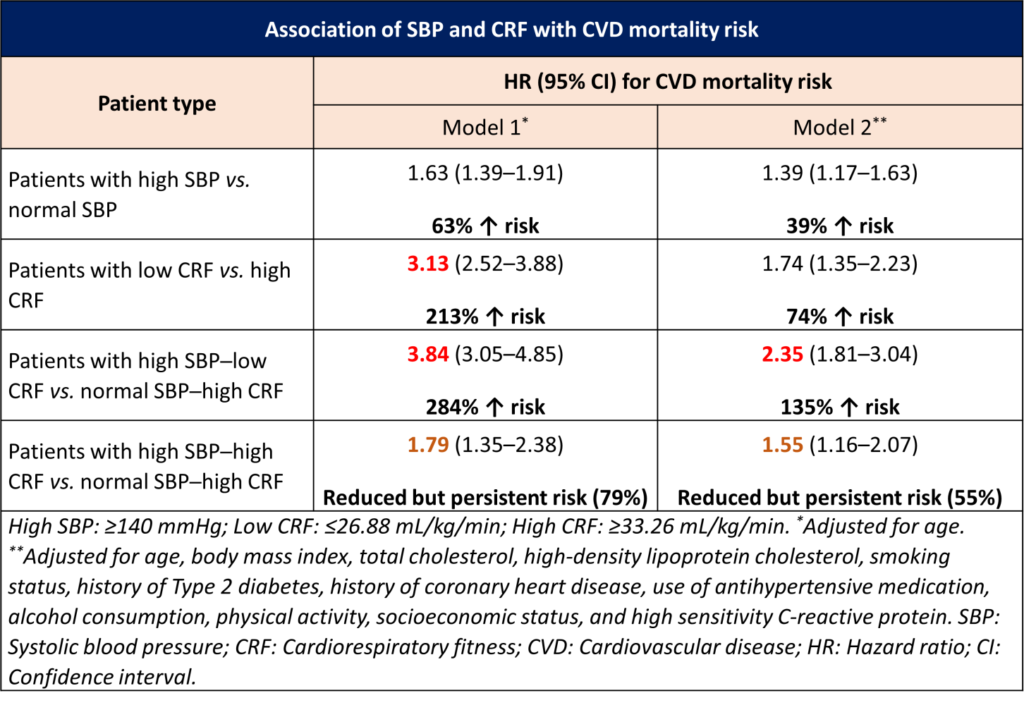
Cardiovascular or cardiorespiratory fitness (CRF) is the ability of the circulatory and respiratory systems to supply oxygen to skeletal muscles during sustained physical activity. It is one of the strongest predictors of mortality, including cardiovascular disease (CVD) mortality. High levels of CRF have been documented to reduce all-cause or CVD mortality risk. A new study, recently published in the European Journal of Preventive Cardiology, reported high CVD mortality risk in people with low CRF levels and high systolic blood pressure (SBP), a known CVD risk factor. Further analysis revealed that high levels of CRF can reduce, but not eliminate, the high CVD mortality risk in people with high SBP.
This prospective cohort study enrolled 2,280 middle-aged and older men (42–61 years of age). Screening and baseline assessments were done from March 1984 and December 1989. Mean of all resting blood pressure (BP) measurements were calculated (resting BP was measured using a random-zero sphygmomanometer on three occasions between 8:00 and 10:00 a.m., following a supine rest of 5 minutes). Peak oxygen uptake was measured for CRF and was assessed by gas analysis during an exercise-tolerance test, using an electrically braked cycle ergometer. The study participants were categorized into the following groups: normal SBP–high CRF (reference); normal SBP–low CRF; high SBP–high CRF; and high SBP–low CRF. All CVD death events were recorded from baseline till 2018. Hazard ratios (HR) for CVD mortality were estimated using multivariable Cox proportional hazards models with 95% confidence intervals (CI).
At baseline, the mean SBP was 134 mmHg and the mean CRF was 30.3 mL/kg/min. All subjects were followed up for a median duration of 28.5 years; a total of 644 CVD deaths were recorded during this period. Subjects with high SBP and low CRF levels had an increased risk of CVD mortality compared to subjects with normal SBP and high CRF levels (Table). In addition, subjects with high SBP–low CRF showed more than twice the risk of CVD mortality risk but those with high SBP–high CRF had lower but persistent risk of CVD mortality (55%) compared to subjects with normal SBP–high CRF (Table).

Clinical implications
- Cardiorespiratory fitness levels can be increased by regular physical activity and exercise training, which are also implicated in the management of high blood pressure.
- High CRF levels have protective effects on cardiovascular risk, mediated through increased physical activity. This was indicated by reduced risk of CVD mortality in men with high SBP and high CRF levels.
- As SBP is a strong and independent risk factor of CVD risk, it was observed that although CVD mortality risk was reduced with high CRF levels in men with high SBP, it was not eliminated completely.
- It is of utmost importance to maintain high CRF levels, through regular physical activity and exercise training, for lowering the adverse disease outcomes and mortality risk in patients with hypertension.
(Reference: Jari A Laukkanen J, Jae SY, Kurl S, Kunutsor S. High fitness levels attenuate the increased risk of cardiovascular deaths in individuals with high systolic blood pressure. Eur J Prev Cardiol.2023;zwad034. https://doi.org/10.1093/eurjpc/zwad034)
